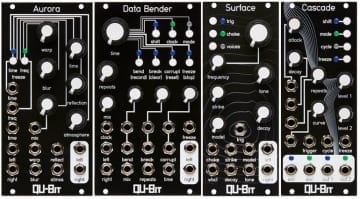Qu-Bit Aurora Spectral Reverb finally shimmers into existence
While Qu-Bit is not at Superbooth it’s taken the opportunity to release the long-awaited Aurora Spectral Reverb which sounds like voltage-controlled whale song.
Aurora
I think we first saw Aurora back at NAMM 2020 along with some other cool Qu-Bit modules such as the Data Bender, Surface and Cascade. It’s been a long road of development but Qu-Bit is confident that it’s ready and we can all now enjoy this slightly weird and wonderful reverb.
So, it’s a spectral reverb which means that it’s not necessarily going to sound or behave like you normally expect. It encourages you to explore new sound spaces that involved cool sounding things like time-stretched tails, cybernetic metallic effects, blurring and spectral artefacts.
Features
You need to know some key things from the controls on the front. Time stretches out the amplitude of the input signal. Blur smears the frequency component of the input. Reflect morphs between multi-delay time zones. Atmosphere controls the spectral and time-domain filtering used to shape the reverb. And finally, Warp adjusts the pitch which can go in either direction for 3 octaves.
You can do some granular stuff with the freeze button to play with the audio that’s currently in the buffer. You can also reverse the audio resulting in reversed reverb swells. That’s really nice.
The results are fascinating. It’s not content to sit in the background as a reverb, Aurora wants to play and shimmer, bend, warp and blur its way into your patch. It has a lovely ethereal quality that has shades of Beads and reverse tape delays. I like this a lot.
The facts
Aurora is based on the Daisy audio platform and features a true stereo input and output. There’s a Phase Vocoder audio engine running inside at 48kHz and 24-bit. The front panel has an annoying USB port for easy firmware updates and other potential applications. It’s 12HP in width and will be available by the end of May for $359.
Qu-Bit calls it voltage-controlled whale song.
You are currently viewing a placeholder content from YouTube. To access the actual content, click the button below. Please note that doing so will share data with third-party providers.

 5,0 / 5,0 |
5,0 / 5,0 | 









